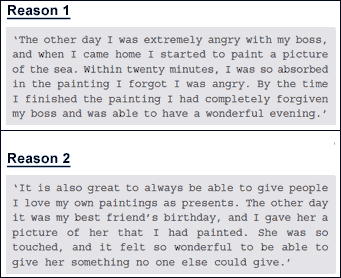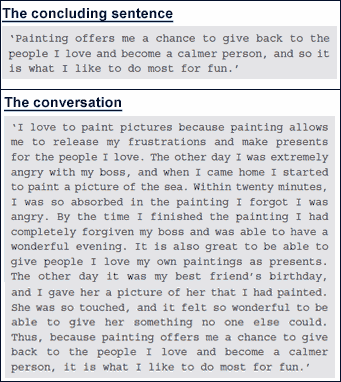
Good communication skills play a huge role in the recruitment process and job applicants who have weak skills are decidedly at a disadvantage. But what exactly are communication skills and how can you perfect yours well enough to get you your dream job?
Nasha Fitter, a teacher, entrepreneur and expert on communications and soft-skilled training, recently launched You're Hired! a book that helps job seekers improve their English communication and job placement skills.
Rediff.com will present a series of excerpts from the book over the coming weeks, and also feature chats with Nasha discussing the topics and intricacies of the job application process.
Here we present the sixth part of the series: Getting to the point
In this chapter we will address another important aspect of effective communication -- speaking and presenting information concisely, i.e., getting to the point quickly! This skill is an especially crucial one in today's hectic world, where everyone is constantly running out of time. No one has the time or patience to listen to endless, unnecessary rambling. Particularly in
business, we are increasingly expected to state our thoughts quickly and crisply -- as the old saying goes, 'time is money'.
In your own experience, have you ever come across people who talk on and on? Doesn't it always seem like it takes them ten times longer than necessary to say what they mean? People like this are called ramblers -- they are annoying and, quite frankly, can be a waste of time. When you are presenting an idea, a statement or answering a question, it is crucial that you are concise and to the point. Similarly, it is essential to focus on your voice quality and body language. Whether you are speaking to one person or giving a presentation to a group, learning these skills will set you apart from the crowd and help you in your professional life.
Excerpted from You're Hired! (Rs 199) by Nasha Fitter with the permission of publishers Penguin Books.
In this continuing series, we will be featuring excerpts from You're Hired! covering topics such as pronunciation, speech, accent, email, interpersonal communication and professional etiquette. Get useful interview tips at Nasha's blog: https://nashafitter.rediffiland.com. So if you need help with your job search and career, watch this space!

The introduction should be self-sufficient. It should in itself tell the other person the core of what they need to know. The way to structure an introduction is as follows [in the image alongside]
Let's use an easy example to illustrate the above. You are speaking to a friend and he asks you, 'What do you like to do for fun?' By using this introduction structure, you could say [in the image alongside]
It is important that the introductory sentence be brief and you only state a few 'why' reasons. These 'why' reasons should only relate to the 'who', 'what', 'when', 'where' -- in this example, painting.
Excerpted from You're Hired! (Rs 199) by Nasha Fitter with the permission of publishers Penguin Books.
In this continuing series, we will be featuring excerpts from You're Hired! covering topics such as pronunciation, speech, accent, email, interpersonal communication and professional etiquette. Get useful interview tips at Nasha's blog: https://nashafitter.rediffiland.com. So if you need help with your job search and career, watch this space!

Here, you provide the facts, opinions, examples and quotes that supporty the 'why' given in your introduction.
Support for 'why' (reason 1): release frustrations
Support for 'why' (reason 2): make presents for people who are loved
Notice that these two things only support the 'why' reasons given in the introduction. These two things include actual reasons and examples.
Thus, the listener will have something that makes them remember why you love painting. At this juncture, a common mistake is to start listing other 'what' or 'why' reasons. For example:
'I also love swimming and golfing and reading to my little sister'.
By listing too many other reasons, you are flooding the listener's mind with too much information and are rambling. Remember to support the introductory sentence with the reasons why you love painting rather than listing all the other things you like doing for fun. People do not have large enough attention spans to remember long lists of data. Thus, pick one thing to talk about and talk about it properly.
Excerpted from You're Hired! (Rs 199) by Nasha Fitter with the permission of publishers Penguin Books.
In this continuing series, we will be featuring excerpts from You're Hired! covering topics such as pronunciation, speech, accent, email, interpersonal communication and professional etiquette. Get useful interview tips at Nasha's blog: https://nashafitter.rediffiland.com. So if you need help with your job search and career, watch this space!

There is a famous saying that goes, 'Tell people what you are going to tell them, then tell them, at the end tell them what you have told them.' Remember how I mentioned earlier that people's minds tend to drift while other people are talking? It is crucial that you conclude by re-stating your original thought. This jolts people back into remembering what you began speaking about [refer to the image alongside].
Notice that both the 'why' reasons from the introduction are stated again:
So a conversation like this would read [in the image alongside]
Excerpted from You're Hired! (Rs 199) by Nasha Fitter with the permission of publishers Penguin Books.
In this continuing series, we will be featuring excerpts from You're Hired! covering topics such as pronunciation, speech, accent, email, interpersonal communication and professional etiquette. Get useful interview tips at Nasha's blog: https://nashafitter.rediffiland.com. So if you need help with your job search and career, watch this space!